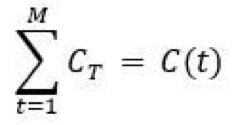Cloud Computing Cost of Capital
The weighted average cost of capital not only helps us understand what it costs to raise money from investors, but it also provides the minimum required internal rate of return for any investment made by a company. A semester’s worth of graduate school finance will help you memorize the formula forever, but the multiple uses of the rate itself is what’s truly handy. Suppose we had a similar metric for determining what “rate of return” we needed when we made the decision to migrate workflows to the cloud? How much easier would it be to make our decisions about whether to pursue cloud computing or not for anything from a single workflow to an entire data center?
The weighted average cost of capital is calculated based on a company’s cost of equity and cost of debt adjusted for taxes. Determining the weighted average cost of cloud (WACC) requires us to define the components of overall infrastructure cost. We will evaluate two specific costs in this context: Cost of Labor and Cost of Infrastructure. Specifically, we do this for Infrastructure as a Service models (IaaS). This model does not work for calculating cost of cloud for Platform as a Service (PaaS). Calculating the cost of migrating to cloud for PaaS is far more complex and beyond the scope of this article.
Cost of Labor
The cost of labor is well understood because salaries are known as well as the internal “burdened” rate used by a company to measure the cost of benefits. This example will use 35% though the rate can be easily changed to account for your own rate. This also allows for the comparison of different types of labor between on-premises and off-premises configurations. The second element in the equation is the time spent supporting the targeted workflow per month. It is necessary to understand the true time spent in the current scenario as well as the expected time spent on the future scenario.
Cost of On-Premises Labor = SUM of total hours worked to support infrastructure x Hourly rate x 1.35 x Number of hours per month
Cost of Off-Premises Labor = (SUM of total hours worked to support infrastructure x hourly rate x 1.35 x Number of hours per month) + (SUM of total hours worked to support infrastructure x
Hourly rate x 1.35 x Hours of extraordinary one-time migration effort OR Cost of consultant or other non-FTE labor)
When calculating off-premises labor, it is necessary to account for one-time setup and/or learning costs for moving to a new platform, so we include that in the cost for off-premises labor. Also take this opportunity to consider or leverage alternative labor possibilities that materialize during these transitions.
Cost of Infrastructure
The cost of infrastructure is a bit more complex because we are often not aware of the company’s own cost of capital, the implications of depreciation, and other financial factors. Let us chart a path down the most common scenarios for calculating the cost of infrastructure and we can adjust accordingly if additional information is known. To calculate cost of internal infrastructure, we need to do the following:
Cost of On-Premises Infrastructure = Purchase Price + Maintenance costs for life of infrastructure + Disposal costs at the end of its useful life
Calculating the cost of Off-Premises Infrastructure requires good data from a number of key sources:
> Actual use of infrastructure
> Ingress / Egress bandwidth
> Ingress / Egress storage
> Desired degree of disaster recover / business continuity
First, we must start by defining variables:
CT = Present value cost of off-premises infrastructure
C0 = Cost of off-premises infrastructure in first month
CFV = Future value cost of off-premises infrastructure
M = Length of off-premises usage, in months
t = A period in term M, starting with 1
R = Rate of linear growth in the consumption of off-premises infrastructure
i = Rate of inflation
Now we can begin with pricing for off-premises infrastructure for the first month:
C0 = (Cost of CPU’s + Cost of memory + Cost of storage + Cost of performance storage + Cost of cache + Cost of bandwidth + Cost of HA / BCP)
We then have to choose a rate of growth (R) because we can reasonably assume that consumption will increase from month to month. To keep it easy, we will consider this growth to be linear. With this rate of growth in mind, we must find the cost of off-premises infrastructure for each period t of the overall term (M) of usage for off-premises infrastructure.
CFV (t) = C0 * (1+R)t
We must, however, account for the time value of money, since cloud dollars paid tomorrow are worth less than they are worth today:
C(t) = CFV (t) / (1 + (i/12) )t
Next, we must find the sum of all C(t) to generate CT, our total cost of off-premises infrastructure for the entire term:

Lastly, renting resources instead of purchasing results in the loss of the depreciation tax shield. To accurately compare on-premises cost vs. off-premises cost, we need to quantify the tax shield we are losing and add it to the final cost of off-premises infrastructure. Since we know the cost of on-premises infrastructure and the depreciation term for equipment in our organizations, we can take each term’s depreciation amount and multiply it by our tax rate to understand how much shield we are giving up. This should be added to CT above to finalize our cost of off-premises infrastructure.
Comparison
To be able to compare the calculated costs of on-premises and off-premises infrastructure fairly, we need to ensure a few things:
Off-premises terms match either the depreciation schedules or technology refresh schedules for on-premises infrastructure. Often on-premises infrastructure is purchased prior to full depreciation of existing equipment and the older equipment is redeployed for other uses. Off-premises calculations should match these use cases.
A realistic rate of growth: This should closely follow our internal growth rate of consumption for on-premises resources. The formula above assumes CPU / RAM / and storage grow in tandem. If our model is radically different, the formula can be easily amended to match specific use cases.
Modern costs of infrastructure are used: Though costs of hardware drop over time, the costs of Input/Output stay remarkably constant. It is important to recalculate off-premises costs as well.
Time Value of Money: Account for time value of money when calculating each C(t) because tomorrow’s dollars will likely be less than they are worth now. On-premises infrastructure is a one-time purchase in “now” dollars.
Conclusion
More often than not, this model will show that on-premises costs are cheaper over time than off-premises cost. This is driven by the relative newness of off-premises computing mass adoption. We expect that as off-premises compute resources continue to gain mass adoption, the true differentiator will be the quality of storage behind off-premises solutions. Not only will it be the true differentiator, it will also be main determinant of cost. This is not different than today’s reality as it relates to compute/storage infrastructure spend and as such, we should not expect a radically different result for off-premises computing.
Our team at Edge Solutions is dedicated to helping provide technology consultation to help you meet your business objectives—from cloud computing recommendations to on-premises enterprise infrastructure solutions. For the latest in IT solutions and services, please call Edge Solutions at (888) 861-8884 or contact us online.
About Mauricio Rojas
Visionary. Technologist that makes things happen. Passionate about education for everyone. As our director of professional services, Mauricio (\”Mo\”) is taking Edge Solutions to the next level by helping our customers look to the future, all while making the current IT project the best that it can be. His expertise in leading IT organizations for Fortune 500 companies enables him to provide great insight to clients of all sizes.
